FC Barcelona: Mes Que Un Club
This is how FC Barcelona leverages the assets it has to win it all
Futbol Club Barcelona, familiarly known as Barça, is one of the most successful soccer clubs in history and it has dominated the world soccer scene for the past 10 years. Many would attribute this success to the rise of Messi, but in reality this is only a part of the story and the lion’s share of the rise of Barça stems from the exploitation of a business model that utilizes the club’s history and its idiosyncratic view of the game to capture value and win championships.
The Business Model
Barça, as a private entity wholly owned by its fans, has a rather unique business model where it captures value not by maximizing returns to its shareholders but by winning the championships its fans covet. Hence, Barça as a club and an entity, exists solely to provide entertainment to its fans and in order to do this it needs the resources to maintain a competitive style of play that allows it to edge the likes of Real Madrid, Manchester United and Bayern Munich in the pursuit of footballing supremacy.
The Operating Model
Barça successfully deploys its assets in the pursuit of value through the following channels:
- The club uses its long history and success to create deep bonds with its fans and build its brand across the world. This brand loyalty in turn facilitates the consumption of related merchandise that makes use of Barcelona’s image and further promotes the club to those who are not familiar with it.
- The club has a strong internal culture that aligns its style of play vertically from the youth teams to the senior squad. This facilitates the development of top talent – i.e. Messi, Puyol, Iniesta, Busquets, Xavi, Alba, Valdez, Pique, etc. – while at the same time giving the club cohesion and a particular play identity that is easily recognizable by fans. This, in conjunction with successful leveraging of the club’s history, constitutes the entity’s ethos and it also provides the Barça with a steady stream of top talent that it can either promote to its senior squad or sell to other teams for cash.
- Barcelona complements its home-grown talent with acquisitions of top talent from around the world. In the past three years, the club has signed both Neymar and Luis Suarez and these two players have combined with Messi to create the most lethal attacking trio in the history of the game. Before them, Barcelona bought stars like Kubala, Cruyff, Neeskens Maradona, Laudrup, Romario, Rivaldo and Ronaldinho; the result being that these acquisitions have not only led to on-pitch success but also expanded the reach of Barcelona’s brand by facilitating access to these players home markets.
- Barcelona exploits this brand loyalty and the allure of its mythology to secure favorable marketing arrangements with leading firms as well as securing better economic terms from its broadcasters. This commercial arrangements provide the club with the cash it needs to fund its internal operations as well as to acquire top players from other teams.
- The club utilizes its training season as a promotional aid that expands the reach of the team to territories where it doesn’t normally play. Hence, the club utilizes its off season to schedule friendly matches in Asia and North America, receiving significant compensation per match played as well as furthering its marketing goals.
How it All Comes Together
As mentioned above, Barça’s end goal is not to turn a profit but to win tittles and this is the reason why it needs to maximize its revenues. The club’s success has been entirely reliant on its ability to leverage its assets (history, culture, players, brand and size) through its daily operations to derive the revenues it requires to fund itself and acquire top talent from other clubs; this has led to spectacular results both on the field and off of it resulting in revenues of over $700 million per year, a valuation north of $3 billion and winning 4 UEFA Champions Leagues, 7 Spanish Leagues, 3 King’s Cups, 6 Spanish Supercups, 3 European Supercups and 2 FIFA Club World Cups in the past 10 years.
The Second Treble
Sources
- http://www.footyheadlines.com/2015/06/barcelona-to-sign-record-breaking-qatar-airways-shirt-sponsorship-deal.html
- http://barcacentral.com/2015/01/12/neymar-suarez-and-messi-too-much-for-atletico/barca-3-1-atletico-suarez-neymar-and-messi-2015/
- https://www.quora.com/What-is-the-business-model-of-FC-Barcelona-and-how-does-it-work-What-about-other-famous-football-teams
- http://www.forbes.com/sites/kurtbadenhausen/2014/07/29/fc-barcelona-reports-record-revenue-topping-700-million/
- http://www.forbes.com/teams/barcelona/
- http://www.fcbarcelona.com/club/history
- https://en.wikipedia.org/wiki/FC_Barcelona
- http://www.fcbarcelona.com/football/first-team/detail/article/barca-make-history-with-second-treble


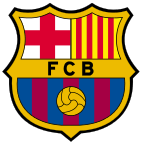

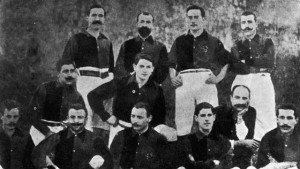
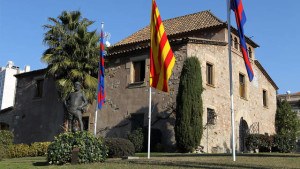
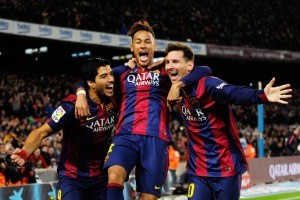
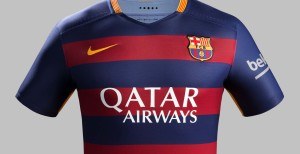
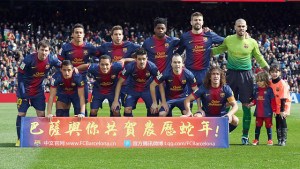
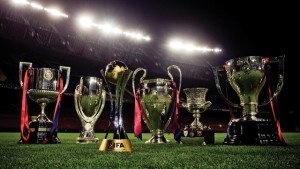
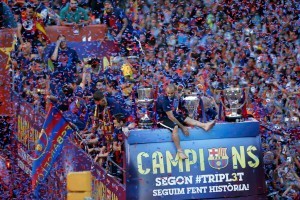
Francisco, as you know I have been a Barca fan since the Van Gaal days in the 90s.
Barcelona’s style of play, youth program, coaching selection and player acquisitions have set it apart from competitors. What I am struggling to understand is why a club with such a storied history, millions of young fans, an gigantic business puts so much at stake by acquiring star players such as Neymar in a fraudulent manner. With a reported $73.5M sale figure, and a price much higher actually paid, I understand that former club Santos is seeking further compensation from FC Barcelona, and the Spanish taxman is also keen on redeeming lost revenues. One of the biggest soccer scandals of recent time points to large contradiction in Barca’s operational and business models. It is sad for me to say this, but “Mes que un Club”, could not be further from the truth on account of recent stories.
Then again, in a multibillion dollar industry, where the entire top management of industry, FIFA, are being investigated, indicted and detained on corruption charges, perhaps there is a lot more to the story than one storied club.
The Neymar case is a basic rehash of what we have observed in many of our FRC cases; competitive pressures and lack of internal and external accountability created an environment where the Rosell administration believed it could reduce the total tax bill for the transfer by hiding its true value.
It is salient to note that FC Barcelona’s governance structure is weak because its Board of Directors (in the sense of a public company) is composed of a subset of club members and it only meets once a year. The management team of the club controls all information and decides what it presents to this board and how it presents it. Because of this structure, the club lacks proper internal compliance mechanisms and management has significant leeway in implementing whatever decisions they see fit. Furthermore, the presidency of FCB is considered a form of high political office in Catalonia and this creates intense competitive pressure to attain and retain power over the club. These two factors combined explain the actions of Sandro Rosell, who has been implicated in several corruption scandals relating to he CBF in Brasil.
It’s also salient to consider how these legal issues affect the governability of the club and its viability. I think the the socio-political context of Catalonia and the position of the club within it is such that its survival is assured no matter what but these scandals can erode the trust rank and file catalans place in the club as an national symbol and institution and thus undermine the history and culture that underpins its operational model.
Boris… sounds like Barca is learning from the Italian clubs!!! 🙁
I hope our friends in Spain don’t succumb to the same kind of disastrous financial pressures and ethical conflicts that have just about destroyed the Italian soccer scene…
Nice post! (but forza MILAN!!!!!)
I hope that the Bartomeu administration can redirect the club and keep itself out of trouble but I don’t have high hopes for them.
Athens ’94, Milan 4 – Barcelona 0. Not fair 😉
… it’s been a while! 🙂
Great post Francisco! As an objective soccer fan, I recognize that FC Barcelona has done a great job in the last 10-15 years in building the structure it has today and in promoting players from La Masia. They have been loyal to a style of play that proved to be both entertaining and effective. That indeed substantiated the great success of the Spanish National Team in the 2008-2012 period.
However, l believe that much of the competitive edge for FC Barcelona and Real Madrid comes from the lack of level playing field in the Spanish La Liga with the unbalanced distribution of TV rights. That makes them alternate at the top every year (with few exceptions such as Atletico de Madrid in 2014) and increase more and more the gap with small teams. It became normal to have Barça and Madrid making 95-100 points (out of 114) in the last 6 seasons. And that never happened before in Spain. Hopefully the new TV deal enacted for the season 2016/17 will make that gap shrink and increase the competition level a bit.
Secondly, I wanted to comment on the youth program operating model and raise another red flag. I see that as the main success driver for the club, with the emergence of Messi and Iniesta as the best examples here. I think this is the right approach and I have always been missing something similar for Real Madrid. That said, Barça incurred also in inapproriate acquisition of young international players that was not compliant with FIFA rules. And now you have the ban on transfers the club was imposed for this practice. FC Barcelona should implement effective control to avoid these situations.